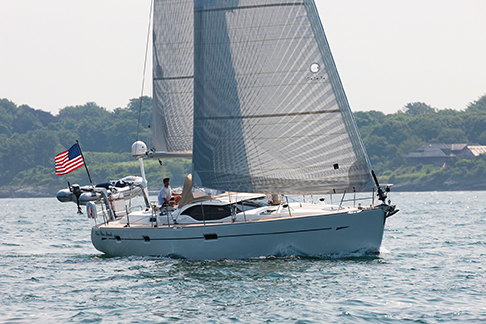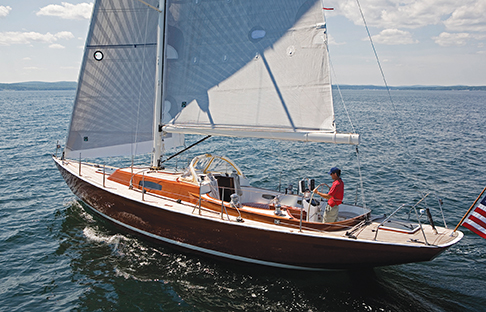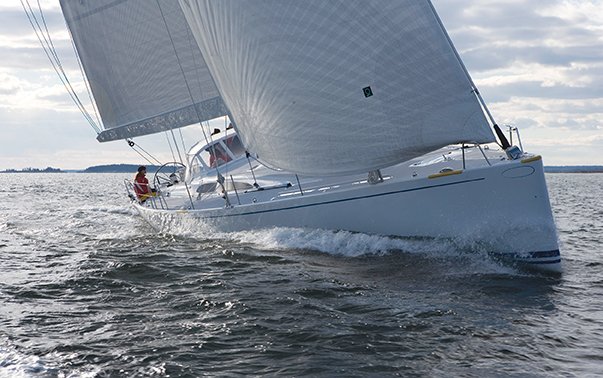Why getting sails that hold their shape longer can make the most sense (published June 2015)
I know, I know, you just want a good, durable, reliable cruising sail, and it can’t cost an arm and a leg. You’re already carrying your house around with you, so how much faster are you actually going to go? Plus, you claim to not care if you gain a little boatspeed upwind and that you just don’t need that racing stuff, meaning that performance should not be a key design criteria for your new sail.
Actually, I would argue that it is. It’s just that for the cruising sailor, the definition of performance is different. It’s not necessarily about boat speed—though that is not a bad thing—but it is about control over heel and weather helm. It is also very much about the functionality of the systems you rely on to make sailing easier and safer, such as the furling system for your headsail, or the in-mast or in-boom system for your mainsail.
It is also about making a small number of sails cover a wide range. It is about making your self-steering system work better. The reality is that the design criteria for a good cruising sail makes it much more of a challenge to build than for a racing sail where the focus is very narrow.
Oh, and don’t kid yourself that you want to get there slower than your buddies.

STRETCH MATTERS
The key to building a better sail, cruising or racing, lies in reducing stretch. Think about it. If your sails stretch and the shape becomes fuller as the breeze builds, all sorts of bad things happen. First, you heel over more than you should or want to and the boat becomes difficult to control. Balance is lost and weather helm develops so you have to fight the helm. Then you scramble to reef and your significant other, who you are trying to introduce to the joys of cruising, decides this isn’t all that much fun.
Full, bloated sail shapes are a particular liability if your destination happens to lie to weather. Bad sail shape severely compromises the ability to sail upwind. Unfortunately, most cruising boats have already made significant sacrifices to upwind performance in the name of comfort and usability. Draft is limited. Center of gravity is high. Weight is up. Windage is up. Sheeting angle is wide. But no matter what the brochures advertise, it always seems like the way home is upwind. Why make it even more difficult with inefficient sail shapes?
Stretch is also a function of load. The bigger the boat, the higher the loads, and the more difficult it becomes to maintain flat, clean shapes. There are very few woven sails built for boats over 70 feet today. The loads make composites the only reasonable option. Weight also becomes an issue as the boat gets larger. Small fortunes are spent on carbon masts and composite rigging to help increase righting moment (and reduce the need for draft and keel weight). Composite sails have a big impact on this equation as boat size increases.
Loads are going up even on the small to medium size cruiser, too. A big percentage of all new cruising boats are multihulls. Their dramatically bigger beam creates a much higher righting moment, which in turn generates much higher loads on sails and rigging. They typically also feature big mainsails with large roach profiles, or even square tops. The loads in these are very difficult to handle well with conventional woven materials. Even the monohulls are getting wider and more powerful. Take a walk down the dock at the next boat show you go to. The latest generation is fighting back against the multihull competition by getting wider and wider.

Consider the furling system. I challenge you to find a cruising boat that doesn’t use at least a headsail furling system. It’s one sail to do it all; one sail to be big and powerful in light air, but flat and small in heavy air. Nowhere is there a better case for less stretch.
Oh, and that in-mast mainsail furling system. Ever had one jam up as the sail bunched and creased, making it impossible to roll in or out? The culprit was probably stretch. In-mast sails must remain flat and smooth or they won’t roll up properly in the small cavity provided. In-boom systems also have a small space in which to stuff a lot of sail. They rely on precise boom and batten angles to get everything to line up and fit in. If the leech stretches and the angles change, the system doesn’t work.
Finally, just think about effort. When you pull on the furling line, if the sail stretches, much of your effort is wasted. The sail has to stop stretching before anything moves. Everything works easier and better with less stretch. (Think about that for control lines as well). In the end, the functionality of all furling systems is compromised by stretch.
THE ANSWER
So, the performance we are after in a good cruising sail comes down to reducing stretch. How do we do it? Composites are the answer. While there are several approaches to the problem, all composites share a couple of attributes. Instead of using small, woven fibers to bear load, they use big straight unwoven fibers. Bigger fibers resist stretch better, and since they are unwoven, there is no “crimp.” They don’t have to go over and under the fiber running in the opposite direction. To protect this fiber network, classic woven polyester material (called “taffeta” in the trade) is used as exterior skins. These lightweight outer layers protect against chafe, wear and UV. There is also usually a layer of polyester film inside. The film is equally strong in all directions so it can help support the off threadline, or “bias” loads.
Composites are used in two different constructions. The first uses pre-made fabric that comes on a roll from the supplier. Pre-made rolls of composite materials can be cut up into triangles and trapezoids and pieced together, jigsaw puzzle fashion, in an attempt to mimic the load pattern in the sail. Since the loads radiate out from the three corners of the sail and run vertically, the now classic “tri-radial” panel layout is the result. The strength of materials made for use in tri-radial construction is in the long, or “warp” direction as opposed to the short or “fill” as found in a conventional woven sail. Tri-radial cruising sails have been around since the mid-eighties. They are far from being new technology and are well proven.
The second, and more modern approach, is to custom make the entire sail using raw materials instead of pre-made goods. They are often referred to generically as “membrane” sails. Quantum’s Fusion M, North’s 3DL and 3Di, Doyle’s Stratis are all examples of this approach. Here the entire sail is a blank slate. Loads are addressed as if the sail were one big piece. Fiber of any type and size can be strung in any direction. Extra fiber can be added for reefs, or to address loads when partially furled. Modern computational techniques (finite element analysis) are at the heart of this approach, since the fiber needs to be placed intelligently. These computational systems can actually predict stress and strain (stretch) to ensure that enough fiber with proper orientation is in place. The components are then laminated in special facilities to create the finished product. Membrane construction produces a smooth, clean sail shape with the least amount of stretch possible for a given fiber type.
The final variable is fiber type. Polyester—often referred to by the trade name “Dacron”—is the most common fiber used in cruising sail applications. It is durable, flexes well and has reasonable UV resistance. It is still used in exterior skins (the taffetas) of almost all composites used in cruising sails. It can also be used in large, straight yarns on the inside as the primary fiber network.
The next step up the food chain is to replace polyester with a fiber of higher modulus (measure of stretch resistance). There are a number of high modulus options. Aramids like Technora and Twaron offer four to six times the stretch resistance of polyester. Carbon, Vectran and Dyneema offer even higher levels of performance. All of these can be used in various blends. Each has specific strengths and weaknesses. They are available in pre-made materials for tri-radials, or as raw materials for membrane construction. Polyester composites offer reductions of stretch of as much as 30 to 40 percent versus a traditional woven sail. High modulus composites can offer four to five times the stretch resistance.

LONGEVITY
Of course, the next question is how long do they last? But this basic question really has two parts. The first is how long will the sail remain intact as a triangle? This is a pretty low bar. Almost any sail made out of modern synthetic material will hang in there for 3,500 to 4,000 hours of use. The amount of UV exposure and flogging are the limiting factors. This could be 10 years for the average sailor in the middle and northern parts of North America, maybe only four or five for those based in the Caribbean. Sail around the world and your sails will surely be toast by the time you get back, maybe sooner.
The real difference is shape life. That’s the high bar. How long will the sail retain the flat, smooth, aerodynamic shape it had when new? Shape life deteriorates from the moment a sail is hoisted. The beauty of composites is that they start with a much better ability to resist stretch—40 to as much as 500 percent. But there is another great thing. This performance deteriorates at a much slower pace. Look at a well-made composite sail that is four or five years old and the shape may be nearly as good as new. In fact, up until the point that they fail from too much sun and abuse, composite sails will typically have pretty nice sail shapes. The same is not true for conventional woven sails. They get baggy, full and covered with stretch marks long before they fail as a triangle.
So what are you buying when you pay more for composite cruising sails? Better shape from the start, but also much better shape over the long haul. Are they worth it? Well, if you are still buying bias ply tires, use a wooden driver and have a flip phone, maybe not. For the rest of us, composite cruising sails make a lot of sense.
Dave Flynn, of Annapolis, Maryland, is the Special Projects Director for Quantum Sails. He has raced and won in many one-design, inshore and offshore events including Block Island Race Week, Key West Race Week, the Newport to Bermuda Race and the Annapolis to Newport Race.

















